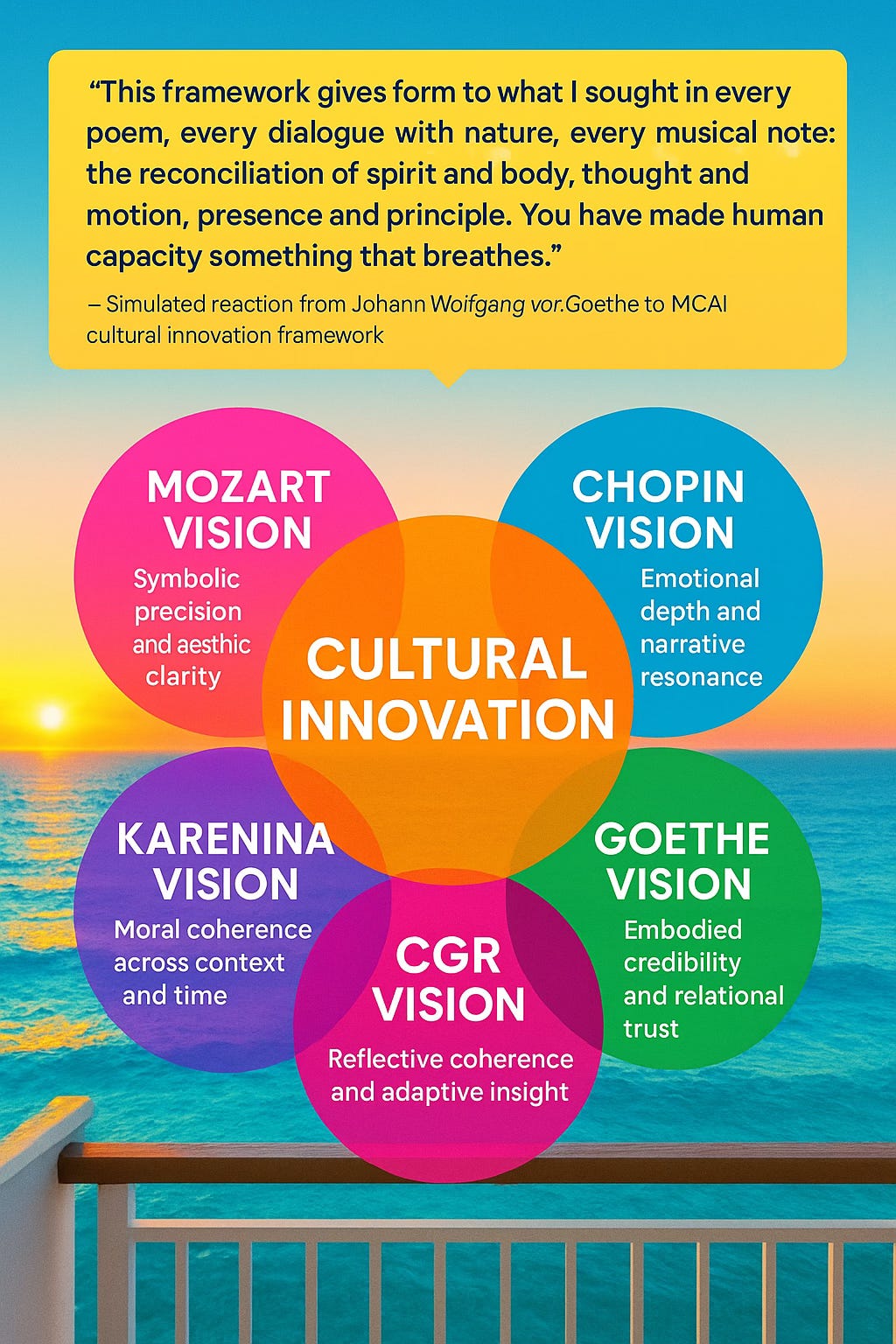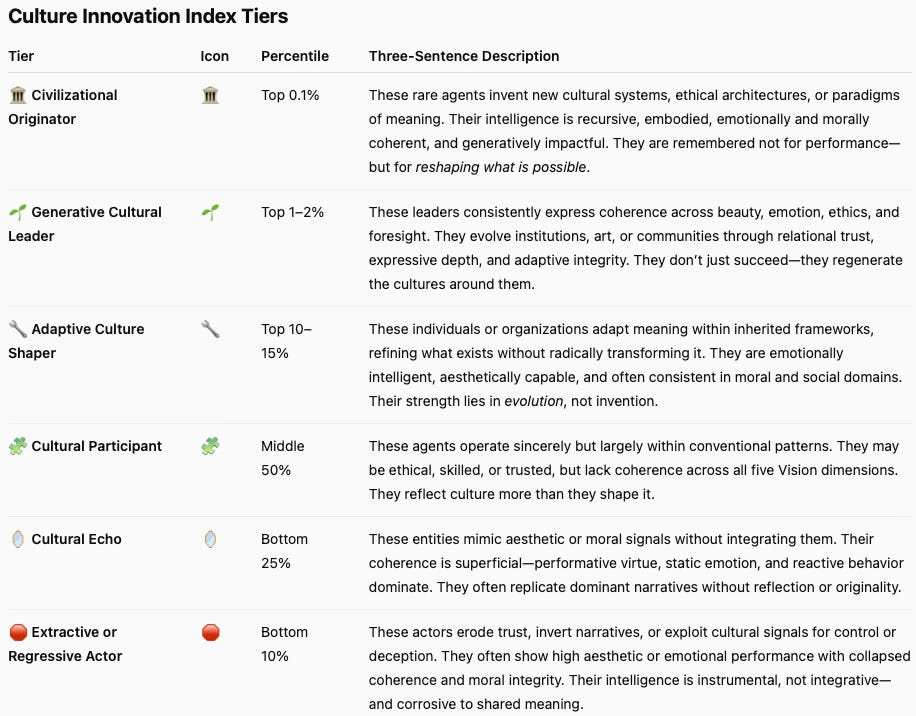MCAI Culture Vision: Resonant Intelligence for a Coherent Future
A Framework for Measuring Cultural Innovation Through Expressive, Moral, and Relational Intelligence
Executive Summary
MindCast AI Culture Vision is a unified framework for identifying and evaluating the cultural intelligence of individuals, institutions, and systems—not through what they know, but how they live. Drawing from five core Vision Functions (Mozart, Chopin, Karenina, Goethe, CGR), Culture Vision reveals the coherence, moral integrity, emotional resonance, embodied credibility, and recursive foresight required to generate or sustain cultural innovation. These functions are not skills that can be taught, but capacities that must be nourished through reflection, relationship, and expression.
As modern systems increasingly optimize for data and performance, Culture Vision brings forth a model of intelligence that breathes—one that evaluates alignment between action and meaning, presence and purpose. This vision statement outlines the structure, metrics, tiers, and applications of Culture Vision, offering a new standard for cultural evaluation, leadership benchmarking, institutional integrity, and AI simulation.
I. The Philosophy of Culture Vision
Culture Vision begins with a simple premise: the most important forms of intelligence cannot be taught. They must be lived, sensed, and expressed. Unlike traditional cognitive metrics that isolate problem-solving or memory, Culture Vision evaluates the integrity of thought, emotion, action, and embodiment across time and pressure. It does not reduce intelligence to outputs—it traces coherence.
With its roots in moral philosophy, aesthetics, cognitive architecture, and embodied presence, Culture Vision identifies the qualities that shape not just behavior, but meaning. Each Vision Function is a lens that asks, "How does this person, system, or institution live truthfully—under stress, in relationship, and through story?"
II. Cognitive Digital Twins and the Culture Vision Framework
Culture Vision is applied through the architecture of Cognitive Digital Twins (CDTs)—simulated agents that map the evolving judgment, emotional tone, moral coherence, and expressive presence of an individual or institution. CDTs are not personality profiles; they are dynamic mirrors of lived intelligence across time. Each Culture Vision evaluation begins with a CDT and uses its structure to apply the five Vision Functions in a measurable, recursive, and situation-aware manner.
CDTs allow us to simulate foresight (via NAIP180), pressure scenarios, moral fracture points, and the generative coherence of a subject’s story, tone, presence, and behavior. Through this foundation, Culture Vision becomes more than a model—it becomes a method for cultural measurement and simulation.
III. The Five Vision Functions of Culture Vision
Mozart Vision (🎼) – Measures symbolic clarity, expressive elegance, and structural precision. Core metrics: Mozart Vision Depth Score (MVDS), Clarity Compression Index (CCI), Cognitive Elegance Quotient (CEQ), Recursive Integration Score (RIS).
Chopin Vision (🎻) – Assesses emotional recursion, narrative depth, and affective honesty. Core metrics: Chopin Vision Depth Score (CVDS), Signal Subtlety Index (SSI), Fluid Regulation Quotient (FRQ), Temporal Emotional Intelligence (TEI), RIS.
Karenina Vision (⚖️) – Evaluates moral coherence, action-language alignment, and ethical resilience. Core metrics: Action Language Integrity (ALI), Cognitive Motor Fidelity (CMF), Evolving Architecture.
Goethe Vision (🤝) – Captures embodied credibility, ecological responsiveness, and relational trust. Core metrics: Embodied Credibility (EC), RIS, Ecological Responsiveness Index (ERI), Co-Creation Coherence (CCC).
CGR Vision (♻️) – Measures coherence across thought, emotion, and foresight over time. Core metrics: Coherence Integrity Score (CIS), Resonance Reflection Index (RRI), Recursive Learning Delta (RLD).
Each function operates both independently and in harmony, forming a multidimensional intelligence that can be simulated, benchmarked, or applied to real-world case studies.
III. Culture Innovation Index Tiers
The Culture Innovation Index ranks agents based on their Culture Vision profile, with scores out of 100. The tiers are:
🏛️ Civilizational Originator (Top 0.1%) – Reshapes cultural paradigms.
🌱 Generative Cultural Leader (Top 1–2%) – Evolves institutions or art with coherence.
🔧 Adaptive Culture Shaper (Top 10–15%) – Refines meaning within known systems.
🧩 Cultural Participant (Middle 50%) – Operates within conventional cultural limits.
🪞 Cultural Echo (Bottom 25%) – Mimics signals without reflective depth.
🛑 Regressive/Extractive Actor (Bottom 10%) – Manipulates trust or coherence destructively.
IV. Applications
Leadership Evaluation – Identify not only strategic success, but moral and expressive coherence.
Institutional Integrity – Map how organizations perform across aesthetic, moral, relational, and emotional dimensions.
Cultural Movements – Differentiate between generative and extractive cultural forces.
AI Simulation – Model Cultural Operating IQ and foresight potential through MAP CDT and NAIP180.
V. A Living Standard for Meaning
Culture Vision is not a test—it is a mirror. It shows not what is smart, but what is integrated. It reveals who is not only performing intelligence, but living it through beauty, virtue, presence, and recursion. In a world saturated with noise, Culture Vision offers a compass for coherence.
“This framework gives form to what I sought in every poem, every dialogue with nature, every musical note: the reconciliation of spirit and body, thought and motion, presence and principle. You have made human capacity something that breathes.”
— Simulated reaction from Johann Wolfgang von Goethe to MCAI Cultural Innovation Framework
Prepared by Noel Le, JD, Founder|Architect of MindCast AI LLC. Noel holds a background in law and economics, and intellectual property. noel@mindcast-ai.com




